Yu-Gi-Oh! is a card game that has an anime and manga series to help promote the game. Before Sevens, the Booster Packs would often contain cards used by a character from one of the Yu-Gi-Oh! anime/manga series. Over the years, many cards were adapted from the anime/manga. Sometimes the cards are buffed, sometimes they are nerfed… However, sometimes they just have their effect changed completely. This article will look at the cards whose card effects (or even Card Type) changed completely when being adapted to real life.
Neos Wiseman
OCG: C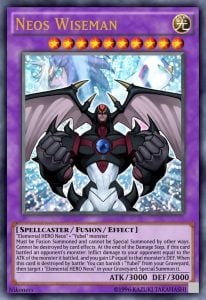 annot be Normal Summoned or Set. Must be Special Summoned (from your hand) by sending 1 face-up "Elemental HERO Neos" and 1 face-up "Yubel" you control to the Graveyard, and cannot be Special Summoned by other ways. This card cannot be destroyed by card effects. At the end of the Damage Step, if this card battled an opponent's monster: Inflict damage to your opponent equal to the ATK of the monster it battled, and you gain Life Points equal to that monster's DEF.
annot be Normal Summoned or Set. Must be Special Summoned (from your hand) by sending 1 face-up "Elemental HERO Neos" and 1 face-up "Yubel" you control to the Graveyard, and cannot be Special Summoned by other ways. This card cannot be destroyed by card effects. At the end of the Damage Step, if this card battled an opponent's monster: Inflict damage to your opponent equal to the ATK of the monster it battled, and you gain Life Points equal to that monster's DEF.
Anime: This card cannot be destroyed by card effects. If this card battles an opponent's monster, inflict damage to your opponent equal to the ATK of the target monster, and gain Life Points equal to that target monster's DEF. When this card is destroyed by battle, you can remove from play 1 "Yubel" from your Graveyard to Special Summon 1 "Elemental Hero Neos" from your Graveyard.
The real-life version of Neo Wiseman has a nerfed effect compared to the anime version. It lost its ability to revive Elemental HERO Neos from the Graveyard if it was destroyed by battle. However, this adaption is strange because it's not a Fusion Monster anymore. In the anime, Neo Wiseman is a Fusion Monster, fitting into Judai's proficiency in Fusion Summoning. In fact, the summoning of Neo Wiseman was symbolic as Judai used Super Polymerisation to fuse Neos and Yubel by discarding Winged Kuriboh, symbolizing that he's uniting all his duel spirits. Yet, Konami decided to change this card into an effect monster.
Konami may have thought that it would be too broken to leave it as a Fusion Monster, so they turned it into an effect monster. This change alone ruined Neo Wiseman's playability since a player would need to hard draw this card to play it. To make matters worse, they'll also need to go out of their way to have both Neos (A Level 7 Normal Monster) and Yubel on the field. It is hilarious that Konami decided to fix this blunder by releasing Elemental HERO Neos Kluger years later. Elemental HERO Neos Kluger has the same effects and Fusion materials as Neo Wiseman.
Fossil Dyna Pachycephalo
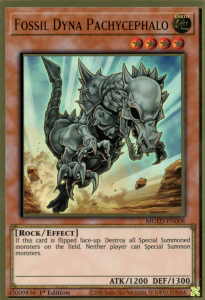 OCG: If this card is flipped face-up: Destroy all Special Summonedmonsters on the field. Neither player can Special Summon monsters.
OCG: If this card is flipped face-up: Destroy all Special Summonedmonsters on the field. Neither player can Special Summon monsters.
Anime: If this card destroys an opponent's monster by battle, it is changed to Defense Position at the end of the Damage Step. Then, it gains DEF equal to the DEF of the destroyed monster until the End Phase of your opponent's turn.
Fossil Dyna is a monster that technically belongs to the Fossil Fusion archetype since Jim Crocodile used it in the anime. The OCG counterpart of Fossil Dyna is COMPLETELY different to the Anime counterpart. The anime counterpart is an aggro battle-orientated monster with a backup defensive effect after destroying a monster. Meanwhile, the OCG version had a destructive anti-special summoning floodgate ability. The OCG version is much superior to the anime version and has historically found use in anti-meta decks. Whereas, suppose Fossil Dyna was actually released with its anime effect. In that case, it'll probably never see any use since its effect is only helpful if it destroys a monster, which is quite tricky considering how Fossil Dyna's low ATK points.
Despite this, Fossil Dyna's OCG effect also caused several problems with the eventual Fossil Fusion archetype. Fossil Dyna was released way before any Fossil Fusion monsters were released. Due to that, it never got the luxury of having its effect adapted to support the Fossil Fusion archetype like the other monsters used by Jim Crocodile (e.g. Flint Cragger and Shell Knight). In fact, its effect clashes with the Fossil Fusion archetype since its effect would prevent the player from Fusion Summoning.
Cyber Angel Idaten
O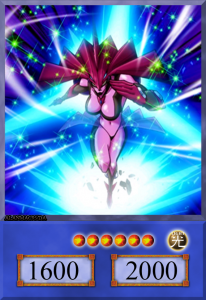 CG: You can Ritual Summon this card with "Machine Angel Ritual". If this card is Ritual Summoned: You can add 1 Ritual Spell from your Deck or GY to your hand. If this card is Tributed: You can make all Ritual Monsters you control gain 1000 ATK/DEF.
CG: You can Ritual Summon this card with "Machine Angel Ritual". If this card is Ritual Summoned: You can add 1 Ritual Spell from your Deck or GY to your hand. If this card is Tributed: You can make all Ritual Monsters you control gain 1000 ATK/DEF.
Anime: This card can only be Ritual Summoned with the Ritual Spell Card, "Machine Angel Ritual". When this card is Special Summoned, you can select 1 Spell Card in your Graveyard, and add it to your hand.
Cyber Angel Idaten is a Ritual Monster belonging to the Cyber Angel archetype used by the main heroine from GX, Asuka/Alexis. In the anime, it was an incredibly useful monster with the ability to recycle a spell card from the graveyard, which is broken in real life. In the OCG, rather than giving it a watered-down version of the anime's effect, it completely changed Idaten into a monster that simply fetches a Ritual Spell from the Graveyard or Deck. This change alone made Idaten from one of the more useful Cyber Angel monsters to one of the more useless ones. Ironically, Benten was made more useful compared to its anime counterpart, thanks to its search effect.
This change was made to Idaten because Konami wanted Cyber Angel to be a mini-engine for Herald or Rituals rather than an actual standalone deck.
The Winged Dragon of Ra
O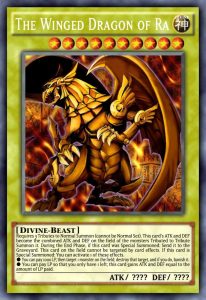 CG: Cannot be Special Summoned. Requires 3 Tributes to Normal Summon (cannot be Normal Set). This card's Normal Summon cannot be negated. When Normal Summoned, other cards and effects cannot be activated. When this card is Normal Summoned: You can pay LP so that you only have 100 left; this card gains ATK/DEF equal to the amount of LP paid. You can pay 1000 LP, then target 1 monster on the field; destroy that target.
CG: Cannot be Special Summoned. Requires 3 Tributes to Normal Summon (cannot be Normal Set). This card's Normal Summon cannot be negated. When Normal Summoned, other cards and effects cannot be activated. When this card is Normal Summoned: You can pay LP so that you only have 100 left; this card gains ATK/DEF equal to the amount of LP paid. You can pay 1000 LP, then target 1 monster on the field; destroy that target.
Manga and Anime: This card cannot be Set. This card can only be Tribute Summoned by Tributing 3 monsters. The Normal Summon of this card cannot be negated. When this card is Normal Summoned, Spells, Traps and other monsters' effects cannot be activated. While this card is on the field. The Summon of this card cannot be negated. Control of this card cannot switch and it is unaffected by the effects of Spell Cards, Trap Cards, and other monsters. Your opponent cannot tribute this card. When this card is Special Summon from the Graveyard, it is sent to the Graveyard during the End Phase. If this card is Special Summoned; Destroy all card(s) your opponents controls. This card can always attack during the turn it is Summoned. This card's ATK and DEF are equal to the combined ATK and DEF of the monsters Tributed to Summon it, respectively. You may pay 1000 Life Points to destroy all monsters your opponent controls. When this card is Special Summon you can use these effects:
●You can Tribute monsters in order to increase this card's ATK by the Tributed monsters' ATK. You can pay any amount of Life Points in order to increase this card's ATK by the amount of Life Points paid. This card can attack Directly. If you use this effect, you can send one "De-Fusion" in your hand or under your control to the Graveyard in order to reduce this card's ATK to 0 and increase your Life Points by this card's prior ATK also negated the attack.
●During either player's turn, you can pay 1000 Life Points, immediately transform "The Winged Dragon of Ra" into its Phoenix Mode. Until the end of the turn this effect is activated, the ATK and DEF of this card are reduced to 0 (the ATK and DEF of this card return to their respective values prior to this effect's use) and it gains the following effects: ● This card cannot be destroyed by battle, and you take no Battle Damage from battles involving this card. ● This card cannot be targeted and is unaffected by the effects of other monsters, Spells, and Traps. The effect of "The Winged Dragon of Ra" only affects this card for one turn.
The Winged Dragon of Ra is an Egyptian God Card. In the anime, Ra, Obelisk and Slifer are three of the strongest cards in the series. Unfortunately, this is not true in the real life game, where they were mostly unviable, with Ra being the worst of the Egyptian God Cards in real life. Ra was severely nerfed and altered when being adapted to real life.
Besides the nerf, Ra was adapted quite uniquely. In real life, Ra was adapted into three different cards, normal Ra, Sphere Mode and Phoenix Mode. In the anime, they were all in one card. It also lost several protection effects and the inheriting ATK points of the tributed monsters effect. For gameplay reasons, it also lost the ability to fuse with the player and have the player recite the chant to unlock Ra's potential.
These changes ultimately made Ra the worst of the three Egyptian God Cards when it's supposed to be the best in the anime. The changes were most likely made to avoid making the card too bloated with effects. However, doing that made the OCG version of Ra utterly different from how Ra was played in the anime (revived from the graveyard to abuse its Phoenix mode). It would take years for Konami to rectify this by printing out Phoenix mode, but that only made it clunkier.
Flying Elephant
OCG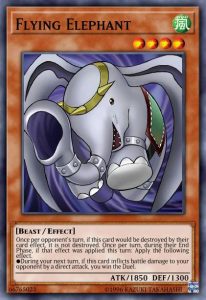 : Once per opponent's turn, if this card would be destroyed by their card effect, it is not destroyed. Once per turn, during their End Phase, if this effect was applied this turn: Apply the following effect.
: Once per opponent's turn, if this card would be destroyed by their card effect, it is not destroyed. Once per turn, during their End Phase, if this effect was applied this turn: Apply the following effect.
● During your next turn, if this card inflicts battle damage to your opponent by a direct attack, you win the Duel.
Anime: As it floats in the sky, it is unaffected by ground-based attacks.
This card has the strangest adaption. Flying Elephant is a card used by an unknown kid in the anime to humiliate Bandit Keith. In the anime, it was a normal forgettable monster that no one expected for it to get released. However, when Konami decided to adapt this card to real life, they decided to give it an effect along with an alternative win condition. In saying that, the win condition is challenging to pull off as it requires your opponent to perform it.
Konami most likely gave it this random alternate win condition to reflect the anime scenario where the kid defeated Bandit Keith with Flying Elephant. However, with how the win condition is set up, I also believe that Konami created Flying Elephant's effect as a joke.
Thousand Dragon
O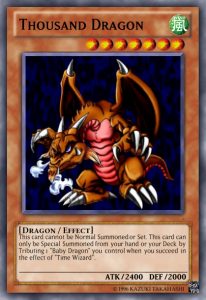 CG: "Time Wizard" + "Baby Dragon"
CG: "Time Wizard" + "Baby Dragon"
Anime: ???
Thousand Dragon is just like its anime counterpart. It's a normal monster with the same stats, so what makes the OCG version different to the anime version? Well, it's the fact that the anime version isn't a physical card.
In the anime, Thousand Dragon is simply an aged version of Baby Dragon when Time Wizard successfully uses its aging effect. However, this didn't translate to the real-life game because Time Wizard's effect is totally altered when adapted to real life (see Time Wizard). In the real-life game, Thousand Dragon was made into a Fusion Monster that requires the player to fuse Baby Dragon and Time Wizard.
Time Wizard
 OCG: Once per turn: You can toss a coin and call it. If you call it right, destroy all monsters your opponent controls. If you call it wrong, destroy as many monsters you control as possible, and if you do, take damage equal to half the total ATK those destroyed monsters had while face-up on the field.
OCG: Once per turn: You can toss a coin and call it. If you call it right, destroy all monsters your opponent controls. If you call it wrong, destroy as many monsters you control as possible, and if you do, take damage equal to half the total ATK those destroyed monsters had while face-up on the field.
Anime: This card can also be played as a Spell Card. When this card is activated or Summoned, you can activate this effect:
● Spin a roulette with a 1-in-2 chance of success. If successful, all monsters on the field are aged. If unsuccessful, destroy all monsters you control, including this card, and take damage equal to half of their combined ATK.
Time Wizard was strangely adapted to the OCG game. First, it lost its ability to be played as a Spell Card. Secondly, they gave it a coin toss Raigeki-like effect. This change causes Time Wizard to lose its anime/manga gimmick where it ages up other monsters, with several monsters being benefited from said effect (e.g. Dark Magician and Baby Dragon). This change ultimately resulted in how Thousand Dragon and Dark Sage were adapted. Both Thousand Dragon and Dark Sage weren't physical cards in the anime/manga, but were made a Fusion Monster and Effect Monster respectively. The OCG Thousand Dragon doesn't reflect how it was summoned in the anime. At least, Dark Sage's summoning condition is similar to how it was played in the anime.
Konami most likely made these changes due to the ruling nightmare of "aging" mechanics.
Elemental HERO Shadow Mist
OCG: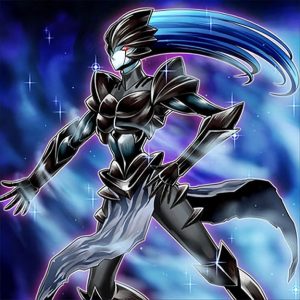 If this card is Special Summoned: You can add 1 "Change" Quick-Play Spell Card from your Deck to your hand. If this card is sent to the GY: You can add 1 "HERO" monster from your Deck to your hand, except "Elemental HERO Shadow Mist". You can only use 1 "Elemental HERO Shadow Mist" effect per turn, and only once that turn.
If this card is Special Summoned: You can add 1 "Change" Quick-Play Spell Card from your Deck to your hand. If this card is sent to the GY: You can add 1 "HERO" monster from your Deck to your hand, except "Elemental HERO Shadow Mist". You can only use 1 "Elemental HERO Shadow Mist" effect per turn, and only once that turn.
Manga: Nothing
Like most manga HERO cards, Shadow Mist was a useless Normal Monster. However, this can't be said the same for the OCG counterpart. The OCG version of Shadow Mist is a staple to all HERO decks focusing on Mask Change and Dark Law. It's also a staple in HERO Decks that don't use Mask Change because it is a searcher. What makes Shadow Mist so incredible is how safe it is. It being a Dark Attribute monster means the player can use it to Summon Dark Law. If you Special Summon it, you get Mask Change from your Deck to Special Summon Dark Law. If it goes to the grave, you get to search out a HERO monster.
To this day, people still use Shadow Mist which shows how well this card has aged.
Orichalcos Shunoros
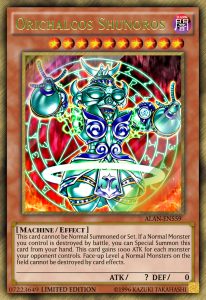 OCG: Cannot be Normal Summoned/Set. Must first be Special Summoned by its own effect. At the end of the Damage Step, if your Normal Monster is destroyed by battle: You can Special Summon this card from your hand. Gains 1000 ATK for each monster your opponent controls. Face-up Level 4 Normal Monsters on the field cannot be destroyed by card effects.
OCG: Cannot be Normal Summoned/Set. Must first be Special Summoned by its own effect. At the end of the Damage Step, if your Normal Monster is destroyed by battle: You can Special Summon this card from your hand. Gains 1000 ATK for each monster your opponent controls. Face-up Level 4 Normal Monsters on the field cannot be destroyed by card effects.
Anime: This card cannot be Normal Summoned or Set. This card cannot be Special Summoned except with "Orichalcos Kyutora". This card's original ATK is equal to the total amount of Battle Damage reduced to 0 by the effect of the "Orichalcos Kyutora" that Summoned this card. When this card is Summoned, you can Special Summon 1 "Orichalcos Aristeros" and "Orichalcos Dexia" from your hand or Deck. After damage calculation, if this card attacked another monster, it loses ATK equal to either that Attack Position monster's ATK or that Defense Position monster's DEF, depending on its battle position. When this card is destroyed while its ATK is 0, you can pay 10,000 Life Points and discard your entire hand to Special Summon 1 "Divine Serpent Geh" from your Deck.
Orichalcos Shunoros is a shell of its anime self. In the anime, its ATK is determined by the damage Orichalcos Kyutora took in battle. It also Special Summons two different monsters that protect Shunoros from battle but slowly reduce Shunoros' ATK each time. The anime Shunoros also sport an ATK reduction gimmick which ultimately helps set up to Special Summon Divine Serpent Geh. The OCG version does none of that. The OCG version is just a simple standalone beat stick that doesn't support Divine Serpent Geh at all. It was instead changed to support Normal Monsters. It Special Summons itself when a Normal Monster is destroyed, and its effect protects the Normal Monster from destruction. The OCG and Anime version of Shunoros are almost different cards.
Orichalcos Shunoros' adaption, unfortunately, suffered from Konami's design philosophy. Konami has shown time and time again that they dislike cards that function in pieces (e.g. Meklord) as it can get quite complicated. Orichalcos Shunoros had the whole "Orichalcos Aristeros" and "Orichalcos Dexia" gimmick removed. Another problem with Shunoros is that it was released at a time when Konami had no plans to adapt The Seal of Orichalcos or Divine Serpent Geh. As a result, it lost all the effects it had to support Orichalcos or Divine Serpent Geh. In fact, many anime cards released during that period suffered the same thing. The other problem with Shunoros is that its effect is quite bloated. Konami has shown time and time again that they would simplify and remove effects if it's too complicated (except Endymion, of course).
Gold Sarcophagus
OCG: Banish 1 card from your Deck, face-up. During your second Standby Phase after this card's activation, add that card to the hand.
Anime: Remove from play 1 card in y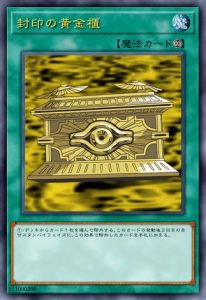 our Deck face-down. If your opponent activates or Summons a card of the same name during this Duel, you can reveal the removed card to negate the activation or Summon of that card, and destroy it.
our Deck face-down. If your opponent activates or Summons a card of the same name during this Duel, you can reveal the removed card to negate the activation or Summon of that card, and destroy it.
This card was adapted very interestingly. Its adaption doesn't even reflect how it was played in the anime/manga. The anime version of this card is similar to Crossout Designator, where it prevents both players from using a specific card. However, the OCG version is a card that fetches a card from your Deck so you can use it in a future turn.
Honestly, both versions of Gold Sarcophagus would've been equally impactful in today's meta (seeing how both OCG Gold Sarcophagus and Crossout Designator are limited). The OCG Gold Sarcophagus is limited for its combo potential with cards that benefit from being banished (e.g. Thunder Dragons, Metaphys, etc). Meanwhile, the anime version (which has a similar effect as Crossout Designator) can be used to prevent hand trap or strong staples from being used.




